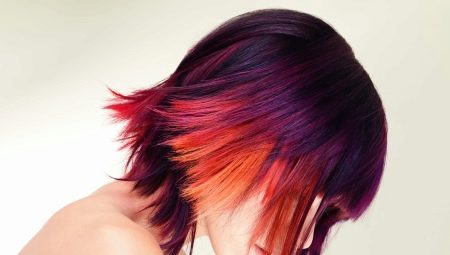If you know a few secrets, then making a fashionable and modern coloring of the tips is quite easy even on your own, at home. To do this, you will need the most ordinary and affordable materials. In our article we will consider the basic techniques and principles of such tinting.
Features
A few years ago, overgrown hair roots were considered to be bad manners and a sign of bad taste. Nowadays, stylists beat everything so that the difference in shades in the root zone and at the tips became an integral part of the modern trend - the main thing is that the painting technique is followed correctly. As a rule, smooth transitions from dark to light are created on the strands, as a result, the effect of curls burnt out in the sun occurs.

Typically, a technique involves the use of 2-4 shades so that the gradient looks as natural and harmonious as possible. However, many fashionistas paint the ends in bright contrasting colors that differ sharply from the shade of their native hair - this option is optimal for brave and daring girls who strive to stand out from the crowd in everything.
Staining the tips allows you to create both feminine images and the most shocking. At the same time, dyeing at home has virtually no restrictions on the part of the used formulations and tool kit - the choice of paint products today is so great that any woman can always choose the best option for herself, taking into account the peculiarities of the structure of the strands.
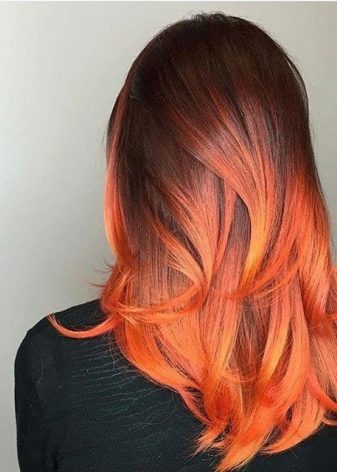
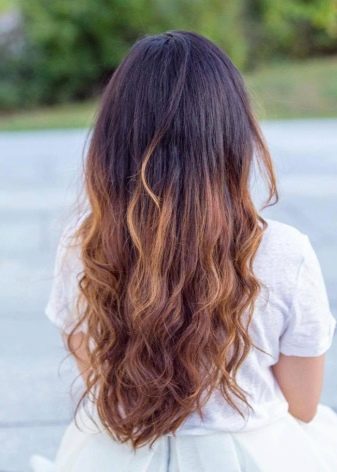
Staining the tips has many advantages.
- Versatility. This technique is used for hair of any type: thin and dense, thick and hard, wavy and straight. Perhaps the only contraindication to staining is the increased fragility and cross section of the strands - in this case, after the procedure they will become even drier, and instead of spectacular color tints, on your head you will get a dry faded washcloth. Agree, few people like this option. That is why, before resorting to dyeing, it is necessary to treat hair with nourishing masks and get rid of sore tips.
- Save time and money. The fact is that as the hair grows, the difference between the native and the colored area does not catch the eye for a long time, because such a hairstyle needs correction no more than once every 3 months, which can significantly save money on going to the stylist or buying coloring compounds for coloring at home.
- The use of a wide variety of paint products. There are no recommendations for coloring compounds: it can be a persistent paint, tinting balm, or natural components such as basma and henna. Some women even color their hair with beetroot and carrot juice, while someone opts for food colors and wax crayons. However, the last option belongs to the category of temporary.
- If you don’t like the result, you can trim the bottom of the hair at any time without much damage to the length. It turns out that you are reliably insured against incorrect coloring or a poorly selected color. This is very true when it comes to medium and long curls.
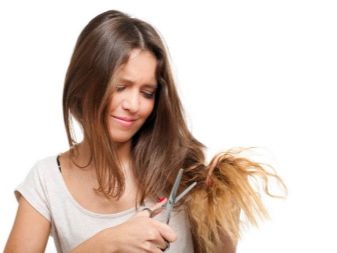
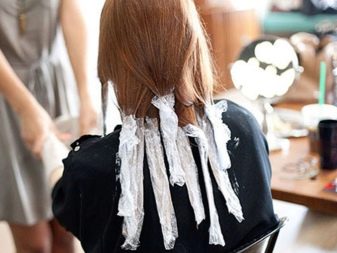
The only drawback of home coloring is the need for self-selection of shades, which is problematic for many girls. In addition, it is better not to experiment with short hair - if something goes wrong, at such a length it will be difficult to cut off the damaged ends.
What is worth remembering?
Before you start dyeing the tips in a different color, you should clearly understand what can be used to tint the hair.
If you need coloring only for a while, for example, for some kind of holiday event or to cheer you up, then usually use colored crayons or mascara for hair. Crayons are visually similar to the most common chalk, they are a dry paint, they are easy to apply, but they are completely uneconomical - to give the ends of your hair a rich shade, you have to spend quite a lot of dye.
Color mascara is considered a more convenient option, it gives a rich and bright color and lays more evenly. Both crayons and mascara belong to the category of short-term products that stay on the hair until the first shampoo.
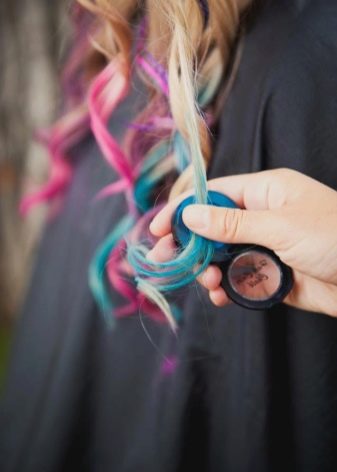
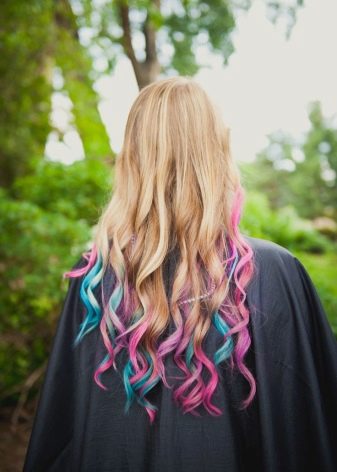
The color obtained with the help of tonics is slightly longer. However, they give only a shade, not a color, therefore they look good exclusively on light curls. To create an elegant and impeccable image in any situation, of course, resort to staining with persistent paints. Usually use one of the following painting techniques.
Ombre
This is a kind of coloring, which involves creating smooth transitions on the hair from one color to another. Most often they use the gradient from dark to light, but the most creative women choose brighter solutions, limiting the color palette only to their own imagination. As a rule, the color begins, retreating from the basal zone by 4-5 cm.
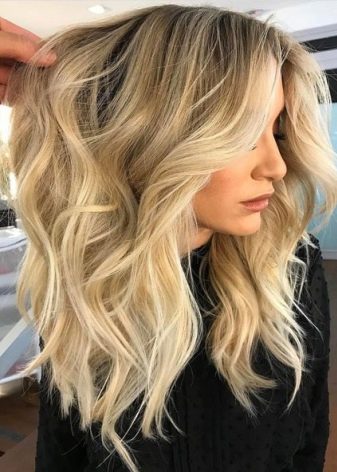
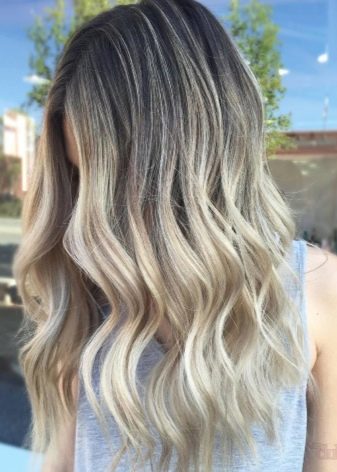
Balayazh
The technique is suitable only for those young ladies who prefer femininity and naturalness - here it is supposed to create the effect of tips burned out in the hot sun. No contrasting juicy tones are unacceptable here - all shades are designed in natural colors, and differ from the native color by no more than 3 tones. Balayazh technique is considered one of the most sparing, it injures hair less than others.
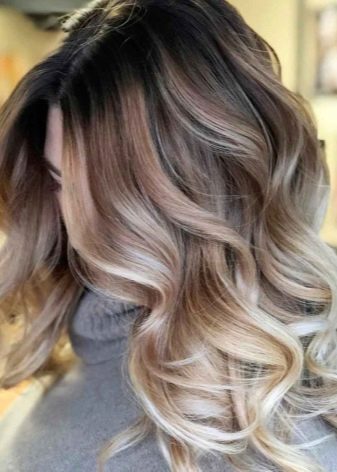
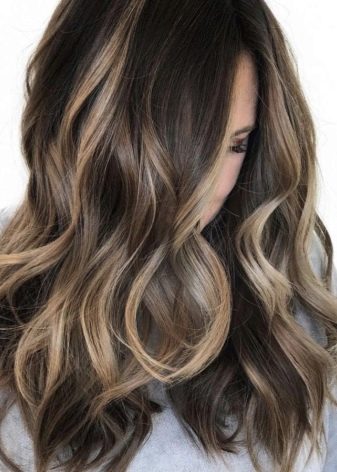
Shatush
Another way to lighten the ends of the hair in one or more shades is called shatush. The technique has a lot in common with ombre and balazyazhem, but here the transition of shades should have a rather blurry, but still pronounced border.
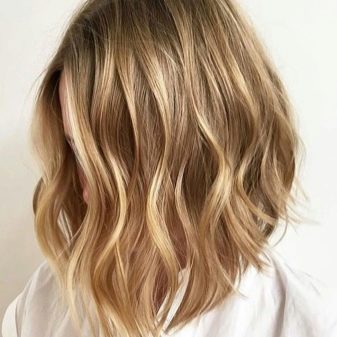

Dip dye
This is a way of coloring for the most daring women who are not afraid of any beauty experiments. The basis is the use of acid, poisonous shades and unexpected gradients. Among young girls, this method of staining curls is most popular.
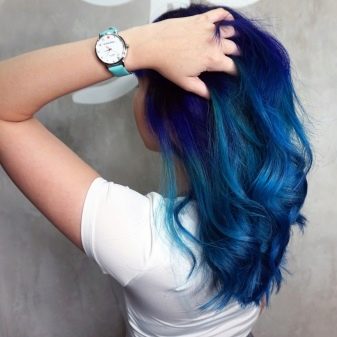

The choice of technology depends not only on personal preferences - here you also need to consider the characteristics of the hair. For example, balayazh can be performed on both short and long hair, but the crank is suitable only for owners of curls below shoulder level. Both methods are suitable for curly hair, while ombre requires a smooth head.
Shade selection
With all the diversity of the color palette and coloring techniques, the types of coloring of the tips, there are only two - these are classic and color.
In the first performance, two main tones are used: darker at the roots, and another, fairly light at the ends. However, in recent years, owners of curls of medium shades, for example, light chestnut or dark blond, can both lighten the tips and give them a slightly darker shades.
Color coloring is much richer and more diverse. It uses from 3 to 20 tones. As a result, you can create soft and smooth tints of color, the effect of burnt strands or highlights that resemble the play of light in the hair.
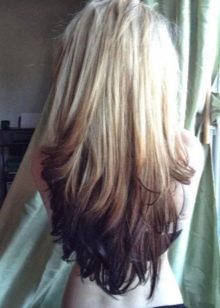
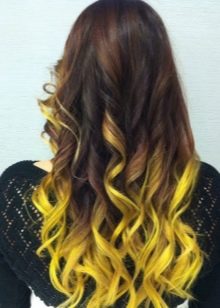
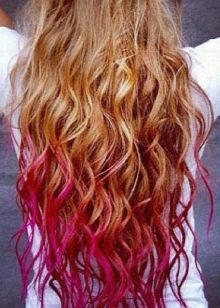
To make the painted tips look fashionable, you need to choose the right shade, here it is important to observe a thin line that separates the flawless image from the sloppiness.
- Women with blond hair, pale skin and fair eyes can be recommended to color the tips in cold shades: platinum, ashy or pearl.
- Girls with dark skin and dark eyes, as well as brown-haired women should give preference to dark, wheat and amber colors.
- If native hair is initially dark, then use cognac, copper and bronze notes.
- As for contrasting shades, there are no rules for their choice. The only advice is to ensure that the design of the strands is consistent with the general style of the woman and the features of her pastime.
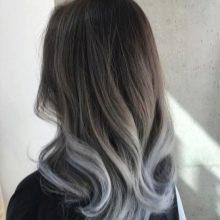
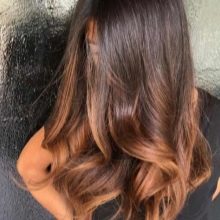
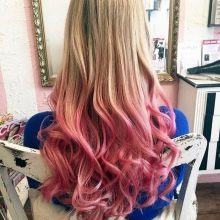
How to paint at home?
If you are determined to dye the ends of your hair, you should prepare your curls in advance. Keep in mind that even the most gentle paints are aggressive chemical compounds and can injure hair, especially if they are in a weakened state. Please note, when brightening the tips, in most cases, preliminary bleaching of the strands is required, so such procedures can cause dry curls and a cross section of the tips. To avoid such problems, the hair needs to be given extra nutrition in the form of masks containing oils, keratins and vitamin-mineral complexes.
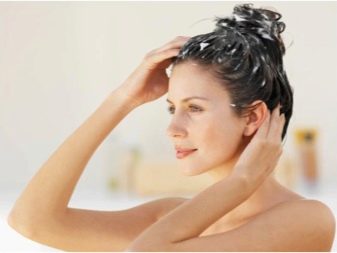

For independent painting at home, you need to prepare:
- paint the desired shades;
- containers for diluting the composition;
- oxidizing agent - if preliminary clarification of hair is required;
- brush or sponge;
- a comb with a sharp separator;
- a brush;
- clamps for strands;
- foil;
- rubber gloves and a cape.

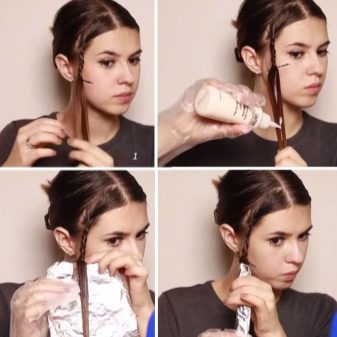
If the hair has a color that is naturally dark or has previously been dyed, then first you need to lighten it. When you need clarification in a couple of tones, you can use a 3-6% oxidizing agent, and if you need more substantial leaching of the pigment, then supra should be preferred. For maximum clarification, oxidizing agents with a 9% concentration are used.
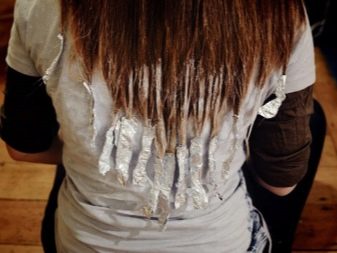
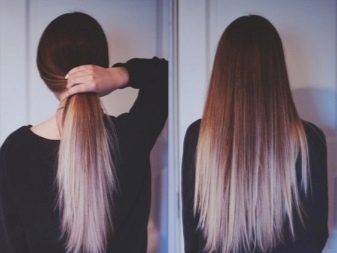
Keep in mind that discoloration is only a preliminary stage of staining, after which the tips will certainly be painted or tinted.
Ombre staining
Having decided on coloring in the ombre style, you need to choose at least two primary colors.For women who prefer bright and saturated colors, such colors as fuchsia and purple, as well as coral or raspberry, will be optimal. However, every woman can always choose other color combinations depending on her own tastes.
The sequence of actions when performing such staining involves several stages:
- to begin with, a darker shade should be applied to the root zone;
- the composition is kept for about 10 minutes, after which the same paint is gently applied to the hair until the middle of the lock, without touching the tips;
- for the remaining length, apply evenly light paint and wrap the hair with foil;
- after keeping the composition for the specified time, it must be washed off with shampoo;
- after thorough rinsing, apply conditioner on colored hair;
- if desired, you can smear the transition tone between dark and light areas, and you need to slightly “shade” the border so that the gradient turns out to be softer.
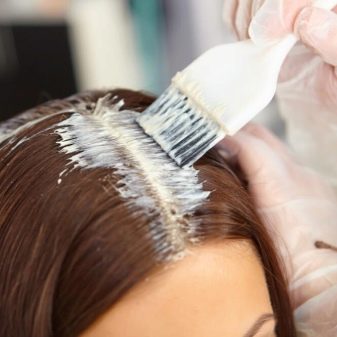
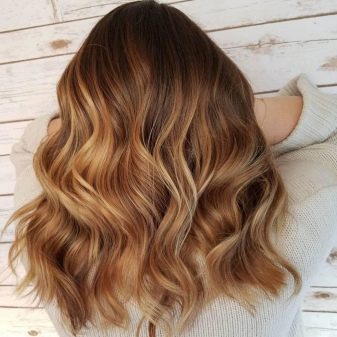
Balayazh
In this design, the color of the tips is very different from the color of the main stock. Thanks to this decision, the tone is effective, and any woman can emphasize her personality.
Step-by-step instructions for performing staining balayazh at home is as follows.
- Select the conditional middle of the strands horizontally, and apply light paint to the lower part, then wrap the individual strands with foil.
- After 10-15 minutes, use a comb to comb the paint down. This will allow for smooth color transitions. Then wrap it again with foil and wait another 20-25 minutes.
- When the time comes, the foil should be expanded, rinse the hair with shampoo, and apply conditioner.
For short and medium curls, the technique is slightly different - in this case, the hair is divided into locks, combed well, and with a brush apply paint, starting from the ends and moving to the middle. If you have no experience with such staining, try applying the coloring paste with your fingers. For this, the hands are dipped in a container with paint and light, “pinching” movements are distributed over the curls.
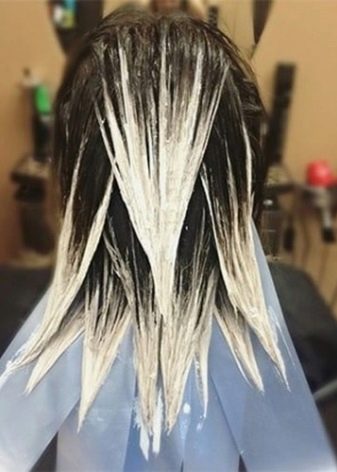

At the end of the exposure time, the dye is washed off and washed with shampoo.
Dip dye
Such staining allows you to conduct the most daring experiments with appearance. Usually blondes resort to such tinting - they cover the tips with paint of brighter shades: blue, red or swamp. The technique in this case is no different from the ombre, with the exception that you do not need to apply the main dark tone to the root zone.
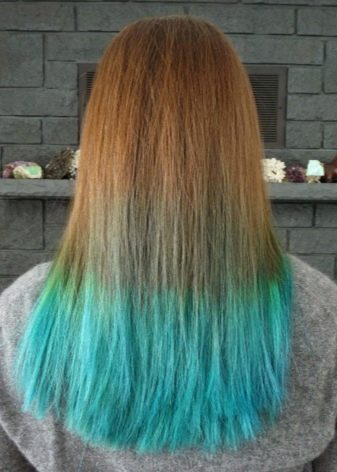
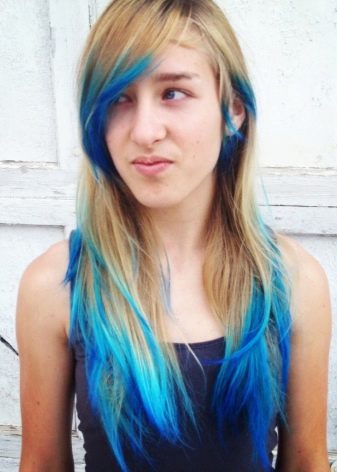
Beautiful examples
A very effective way to look perfect in any situation is to dye the ends of the hair, while the difference between them and the root zone can be both smooth and sharp. Such coloring is for blondes, brunettes, and even women with red hair.
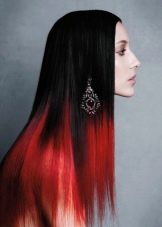
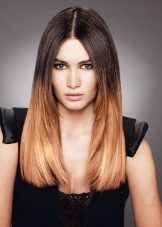
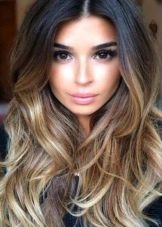
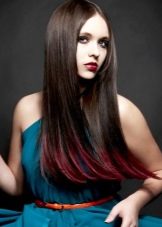
Most often they use transitions from dark to white, but in recent years, painting the ends in pink, lilac, purple, blue and red has become more popular.
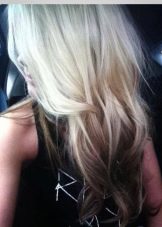
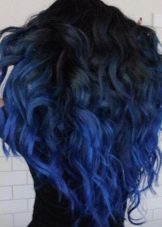
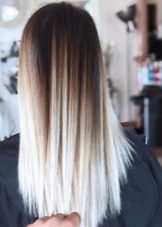
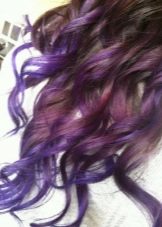
Master class on dyeing the ends of the hair, see the following video:
